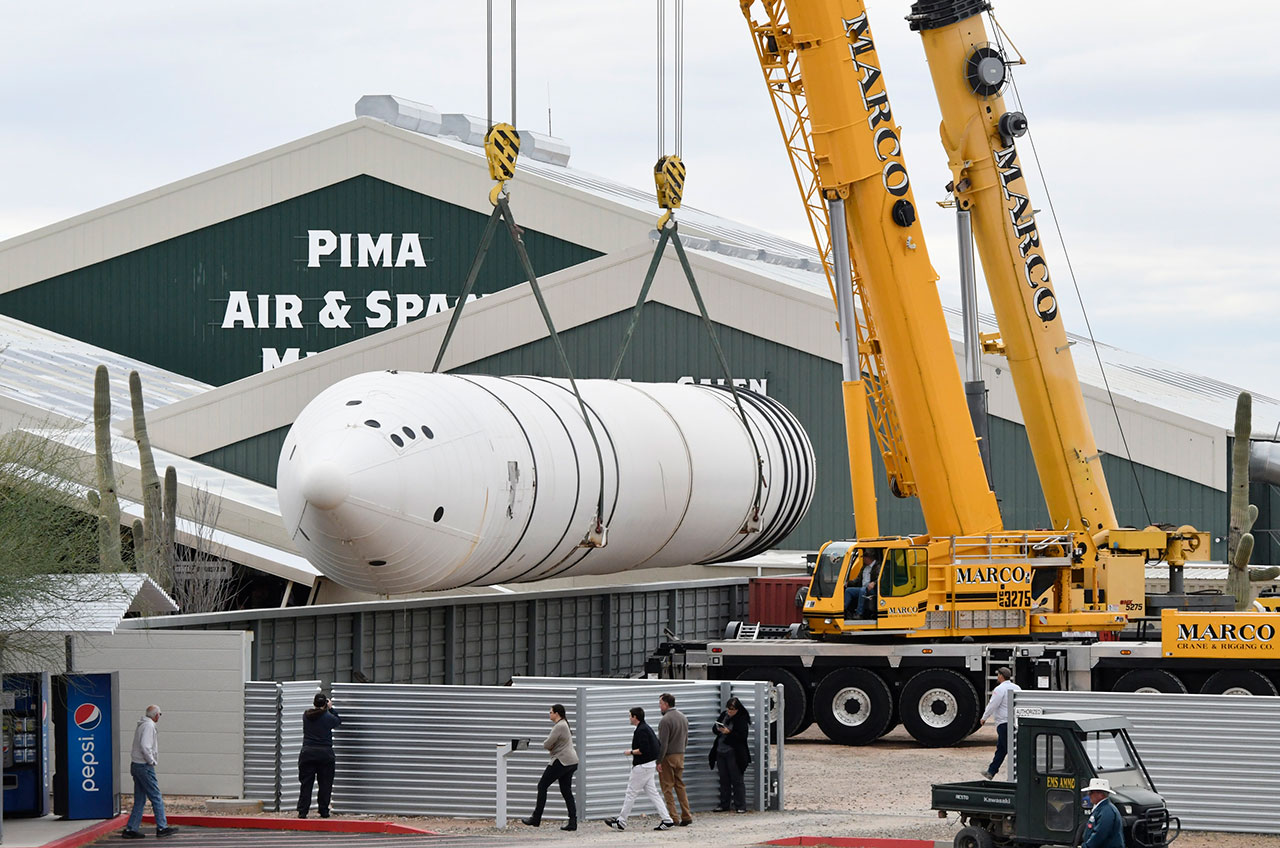Space Shuttle Solid Rocket Booster Arrives for Display at Arizona Museum

Visitors to the Pima Air and Space Museum in Tucson, Arizona now only need to walk a short distance in order to get up close with a very large piece of space shuttle history.
In fact, they only need to go from the museum's parking lot to the walkway leading to the main entrance to encounter the 149-foot-long (45 meter) solid rocket booster that was delivered on Thursday (Dec. 29).
"It will be the first thing that people see when they come," said James Stemm, director of collections at the Pima Air & Space Museum, in an interview with collectSPACE. "The nose cone is pointed towards the parking lot, so you walk along it from the top towards the bottom." [Photos: Solid Rocket Booster Delivered to Pima Air & Space Museum]
The booster, which is built from both authentic and replica parts, represents the solid-fuel motors which were used in pairs to launch the space shuttle from April 1981 through July 2011. The four-segment rockets were each capable of producing 2.65 million pounds of thrust at liftoff.
A five-segment version of the solid rocket booster (SRB), using components that were earlier flown with the shuttle, is planned for use with NASA's next heavy-lift vehicle, the Space Launch System (SLS).
The booster now on display in Tucson was trucked to the Pima Air & Space Museum from NASA's Armstrong Flight Research Center at Edwards Air Force Base in California. The center and museum are only about eight hours apart, but holiday traffic delayed the transport.
"The Arizona Department of Transportation did not want it moved during the immediate run up to Christmas because of the increased travel," Stemm explained. "So, they asked us to wait."
Breaking space news, the latest updates on rocket launches, skywatching events and more!
As it is, the solid rocket booster was a holiday gift, of sorts, from the California Science Center in Los Angeles.
"They had two of them sitting at Edwards and they did not need two, so they offered to give one to us," said Stemm, adding they had been working with the Science Center for about eight months to arrange the transfer.
The two boosters were delivered to the research center in August 2012 to be held for possible use with the California Science Center's planned vertical, launch pad-like exhibit of the space shuttle Endeavour, now slated to open in the new Samuel Oschin Air and Space Center in 2019. Prior to that, the boosters were on display at the Kennedy Space Center Visitor Complex in Florida from 1994 to 2011.
Both boosters were built up of a combination of flight-like and test hardware, as well as mock parts. The forward and aft segments are made of steel, like the type that launched the space shuttle. The center two segments are filament-wound cases of the type that was once planned for use at Vandenberg Air Force Base in California. (The west coast flights were cancelled in the wake of the loss of the space shuttle Challenger in 1986.)
The forward skirt, frustum and nose cap are fiberglass and sheet metal, as are the aft skirt and nozzle.
Mixed pedigree aside, the booster at the Pima Air & Space Museum makes for an impressive display, said Stemm.
"We have many very large artifacts, but this is certainly the largest rocket we have," he stated. "Our space collection is relatively small. Rocket-wise, the only other large one we have is a Thor-Agena."
The museum also displays some small flown artifacts and a mockup of an Apollo command module that was built for CBS News for its moon landing coverage. On the aviation side, it exhibits three Boeing B-52 "Stratofortress" strategic bombers, a Convair B-36 "Peacemaker" and a Boeing 787 Dreamliner jet airliner, among other aircraft and artifacts.
The addition of the rocket booster now adds the Pima Air & Space Museum to the small list of sites where the space shuttle-era vehicle can be seen on display. Other real and replica SRBs are exhibited at the Kennedy Space Center in Florida, the U.S. Space & Rocket Center and Marshall Space Flight Center in Alabama, the Stennis Space Center in Mississippi and at Orbital ATK's Utah test facility, where the boosters were built and fueled for launch.
See more photos of the space shuttle solid rocket booster delivery at collectSPACE.
Follow collectSPACE.com on Facebook and on Twitter at @collectSPACE. Copyright 2016 collectSPACE.com. All rights reserved.

Robert Pearlman is a space historian, journalist and the founder and editor of collectSPACE.com, a daily news publication and community devoted to space history with a particular focus on how and where space exploration intersects with pop culture. Pearlman is also a contributing writer for Space.com and co-author of "Space Stations: The Art, Science, and Reality of Working in Space” published by Smithsonian Books in 2018.
In 2009, he was inducted into the U.S. Space Camp Hall of Fame in Huntsville, Alabama. In 2021, he was honored by the American Astronautical Society with the Ordway Award for Sustained Excellence in Spaceflight History. In 2023, the National Space Club Florida Committee recognized Pearlman with the Kolcum News and Communications Award for excellence in telling the space story along the Space Coast and throughout the world.


